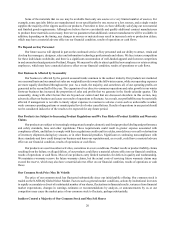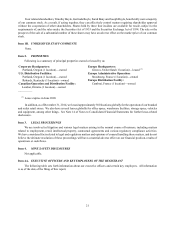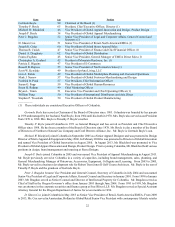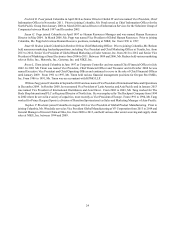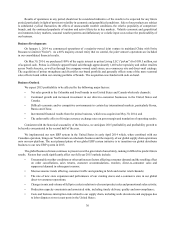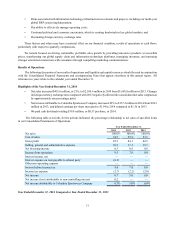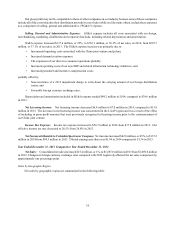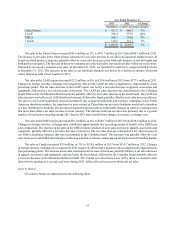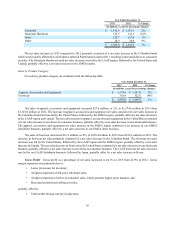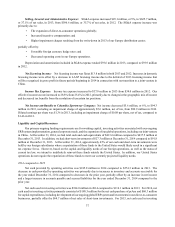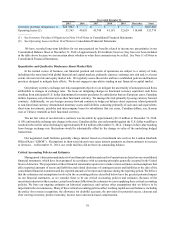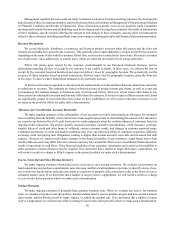Columbia Sportswear 2014 Annual Report Download - page 34
Download and view the complete annual report
Please find page 34 of the 2014 Columbia Sportswear annual report below. You can navigate through the pages in the report by either clicking on the pages listed below, or by using the keyword search tool below to find specific information within the annual report.30
Results of operations in any period should not be considered indicative of the results to be expected for any future
period, particularly in light of persistent volatility in economic and geopolitical conditions. Sales of our products are subject
to substantial cyclical fluctuation, the effects of unseasonable weather conditions, the relative popularity of competitors'
brands, and the continued popularity of outdoor and active lifestyles in key markets. Volatile economic and geopolitical
environments in key markets, seasonal weather patterns and inflationary or volatile input costs reduce the predictability of
our business.
Business Developments
On January 1, 2014 we commenced operations of a majority-owned joint venture in mainland China with Swire
Resources Limited ("Swire"). As a 60% majority-owned entity that we control, the joint venture's operations are included
in our consolidated financial results.
On May 30, 2014, we purchased 100% of the equity interest in prAna Living LLC (“prAna”) for $188.5 million, net
of acquired cash. PrAna is a lifestyle apparel brand sold through approximately 1,400 select specialty and online retailers
across North America, as well as through five company-owned retail stores, an e-commerce site and direct-mail catalogs.
The acquisition of prAna strengthens and diversifies our brand portfolio and generally offsets some of the more seasonal
sales effects found within our existing portfolio of brands. The acquisition was funded with cash on hand.
Business Outlook
We expect 2015 profitability to be affected by the following major factors:
• Net sales growth in the Columbia and Sorel brands in our United States and Canada wholesale channels;
• Continued growth and increased investment in our direct-to-consumer businesses in the United States and
Canada;
• Difficult economic and/or competitive environments in certain key international markets, particularly Korea,
Russia and China;
• Incremental financial results from the prAna business, which was acquired on May 30, 2014; and
• The unfavorable effects of foreign currency exchange rates on gross margin and translation of operating results.
Consistent with the historical seasonality of the business, we anticipate 2015 profitability and profitability growth to
be heavily concentrated in the second half of the year.
We implemented our new ERP system in the United States in early April 2014 which, when combined with our
Canadian operation, brings our North American wholesale business and the majority of our global supply chain operations
onto our new platform. The next planned phase of our global ERP system initiative is to transition our global distributor
business to our new ERP system in 2015.
The global business climate continues to present us with a great deal of uncertainty, making it difficult to predict future
results. Factors that could significantly affect our full year 2015 outlook include:
• Unseasonable weather conditions or other unforeseen factors affecting consumer demand and the resulting effect
on order cancellations, sales returns, customer accommodations, reorders, direct-to-consumer sales and
suppressed demand in subsequent seasons;
• Macroeconomic trends affecting consumer traffic and spending in brick and mortar retail channels;
• The rate of new store expansion and performance of our existing stores and e-commerce sites in our global
direct-to-consumer operations;
• Changes in mix and volume of full price sales in relation to closeout product sales and promotional sales activity;
• Production capacity constraints and associated risks, including timely delivery, quality and non-compliance;
• Costs and business interruption risks related to our supply chain, including work slowdowns and stoppages due
to labor disputes at west coast ports in the United States;


